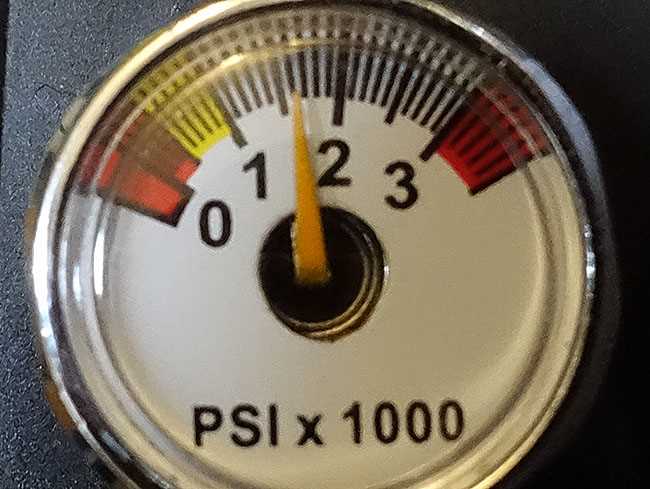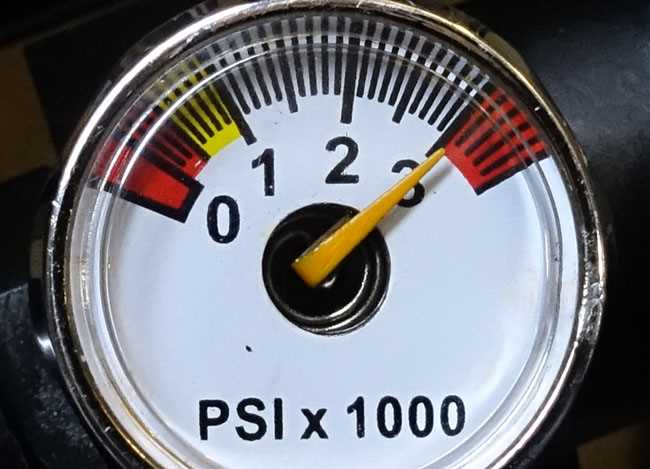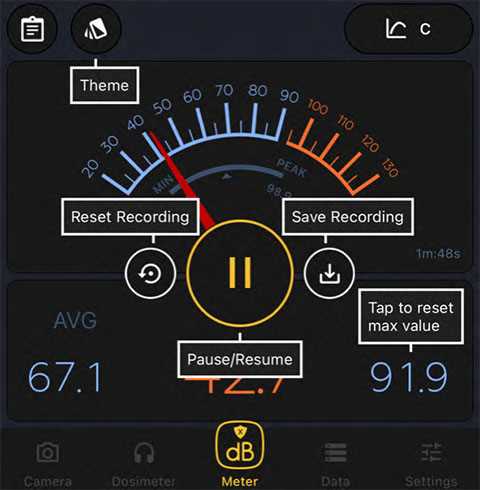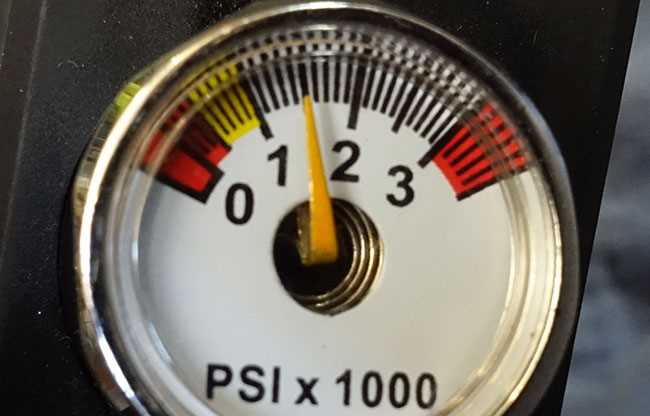This report covers:
- The test
- JSB Exact Jumbo Heavy
- Discharge sound
- The trigger?
- One click down on power
- Two clicks down on power — the midpoint
- Discussion
- Three clicks down on power
- Low power
- H&N Baracuda Match
- Make sure
- Quiet-osity
- Summary
Today we look at the power and velocity of the .22 Benjamin Gunnar I’m testing. Remember the good thing — that this rifle only needs to be filled to 3000 psi, which makes it possible to fill from a pump, plus it won’t drain your carbon fiber air tank on the first fill. We have a lot to discuss and consider, so let’s get started.
The test
I wanted to test several things today — the power, the shot count, the consistency of the regulator, the ease of loading and the trigger. There are five power levels and I want to check all of them as well. So I did a special sort of test and, rather than explaining it, you’ll see it unfold as we go.
JSB Exact Jumbo Heavy
Most of the test was shot with the JSB Exact Jumbo Heavy pellet. You’ll see why using the same pellet for everything is important as we go.
Since the rotary magazine holds 12 pellets, I loaded it full and my strings are either all 12 or a subset of 12. I must say that the Gunnar rotary magazine loads very easily. There is none of the loading the first pellet skirt-first or from the back side of the mag funny business. It loads as you expect it to.
First up was the high power test. The reservoir was full and the regulator was set as it came from the factory.

When the reservoir was filled to 3000 psi, this is where the regulator gauge stopped.

And this is what the reservoir gauge showed after the fill.
Shot…….Velocity
1…………..901 fastest shot
2…………..893
3…………..888 slowest shot
4…………..890
5…………..890
6…………..893
7…………..889
8…………..894
9…………..891
10..………..888
11..………..893
12..………..889
I round off my chronograph numbers to whole numbers, so what you see here is based on that. The chronograph does the average calculation and the decimal fractions are factored in there. The average for this string is 891 f.p.s. The spread is 13 f.p.s. -— from 888 to 901 f.p.s. At the average velocity this pellet generates 31.97 foot-pounds, so there is your 32 foot-pounds that is claimed for the .22-caliber Gunnar.
Discharge sound
How loud is the Gunnar? I was shooting in my garage, into a box of rubber mulch, so there was no sound from the pellet trap. The Gunnar is the quietest powerful PCP rifle I have ever tested! The discharge was 91.9 dB.

The Gunnar is quiet at full power.
The trigger?
I tried the trigger during this test and it was as I told you in Part One — a short first stage and a crisp light second stage. It’s not adjustable, but I wouldn’t if I could.
One click down on power
The detents for the power switch that I showed in Part One cannot be felt, but I could see where the switch was by eyeball. For these next tests I shot only 6 pellets per string, so I didn’t waste all my JSB pellets.
Shot…….Velocity
13…………..885 fastest shot
14…………..876 slowest shot
15…………..884
16…………..879
17…………..877
18…………..880
We have just learned that the power switch is very sensitive and adjusts the power by a small amount when it’s clicked down one click. The average for this string was 880 f.p.s. The spread was 9 f.p.s. from 876 to 885 f.p.s. At the average velocity the pellet generates 31.18 foot pounds of energy.
Two clicks down on power — the midpoint
Shot…….Velocity
19…………..did not register
20…………..862 slowest shot
21…………..863
22…………..868 fastest shot
23…………..863
24…………..868
The average for this string is 865 f.p.s. At that speed the pellet puts out 30.13 foot-pounds of energy. The spread for the string is 6 f.p.s., from 862 to 868 f.p.s.
Discussion
We are seeing almost full power at the midrange of the power switch. If you want a high shot count with power, this would be a way to get it.
Cocking and loading is as smooth as melted butter. The magazine advances perfectly as the bolt cycles.
Three clicks down on power
At this point we are just one click up from the lowest power setting.
Shot…….Velocity
25…………..805
26…………..807
27…………..806
28…………..804 slowest shot
29…………..809 fastest shot
30…………..809
This was a larger drop in velocity than before, but the Gunnar is still hanging in there with power. The average velocity was 807 f.p.s. at at that velocity the pellet generates 26.22 foot pounds of energy. The spread for this string was 5 f.p.s.
Low power
Now I set the power switch as low as it would go.
Shot…….Velocity
31…………..692 slowest shot
32…………..699
33…………..703
34…………..705
35…………..706
36…………..707 fastest shot
This time the power drop was even larger, but I want to make an observation. Other guns with power adjustments often dip to extremely low levels when set to low power. That isn’t the case with the Gunnar. The average velocity for this string was 702 f.p.s. and at that speed this pellet generates 19.84 foot pounds of energy. You can still hunt and shoot at distance with that. The spread for this string was 15 f.p.s., from 692 to 707 f.p.s. I am saying that all five power settings give useful power.
At this point in the test I have fired 36 shots from the rifle. I thought the thing to do was to set the power back to the maximum and see what sort of velocity I got with the same pellet as in the first string. Same JSB Exact Jumbo Heavy pellet was used.
Shot…….Velocity
37…………..891
38…………..897 fastest shot
39…………..885
40…………..889
41…………..889
42…………..886
43…………..888
44…………..889
45…………..884 slowest shot
46…………..886
47…………..886
48…………..892
The average for this 12-shot string at full power was 889 f.p.s. That’s 2 f.p.s. slower than the average of the first 12 shots at full power. So the Gunnar is still on the power curve and doing well.
At the average velocity this pellet generates 31.82 foot pounds of energy. The spread for these 12 shots was 13 f.p.s., the same as for the first 12 shots.
H&N Baracuda Match
Now let’s try a heavier pellet and see what we get. The H&N Baracuda Match weighs 21.14 grains. It’s far from the heaviest .22 pellet, but it will give us a look at what the Gunnar can do. These 12 were shot on high power.
Shot…….Velocity
49…………..850 fastest shot
50…………..842
51…………..842
52…………..841
53…………..839
54…………..839
55…………..842
56…………..841
57…………..837
58…………..839
59…………..837
60…………..831 slowest shot
The average for this string was 840 f.p.s., but I do believe the Gunnar has fallen off the regulator. That may have happened on shot number 60. At the average velocity this pellet generated 33.13 foot pounds of energy. That’s slightly above the specified power for the .22 Gunnar. The spread was 19 f.p.s., but like I said, the rifle is off the power curve.

This is where the reservoir gauge was at the end of the test.
Make sure
Just to be certain that I was right about the Gunnar being off of its regulator I shot one final string of 12 shots with the JSB Exact Jumbo Heavy pellets.
Shot…….Velocity
61…………..873 fastest shot
62…………..867
63…………..860
64…………..860
65…………..848
66…………..847
67…………..848
68…………..839
69…………..836
70…………..830
71…………..825
72…………..817 slowest shot
Looking at this string there can be no doubt that we are off the regulator. However, look at these velocities. They are still good and powerful. The Gunnar is still shooting well.
I didn’t give you a shot count, but it occured to me that I could shoot this rifle several clicks down on power and probably get a lot more than the 60 shots or so that we saw today. I’m thinking that is what Crosman did when they said 90 shots per fill for .22.
Quiet-osity
During the test at an early stage I installed the threaded adaptor and then my DonnyFL silencer. After that the Gunnar on high power was as quiet as a Diana 27. I could hear the pellets hitting the cardboard mulch box that was about 6 feet from me! I didn’t take a sound meter reading, but it was down in the 70s, for sure — probably the lower 70s.

The DonnyFL silencer made the Gunnar very pleasant to shoot.
Summary
Wow! The Gunnar gets lots of shots, has a great trigger, is butter-smooth to cock and load and in all ways seems like a great precharged air rifle. No long-term pronouncements until I see the accuracy, but so far this one is good.



Everyone,
I don’t know why this post didn’t publish. It was scheduled correctly and when I looked at it just now, nothing was wrong. It just failed to publish.
BB
It made it in time for me!
It seems that in the mid-range of power that the regulator was more efficient, giving a smaller spread in velocities. That was with the “short” spread, but it is also probably correct as the regulator is working more efficiently to maintain the pressure. Also, as time goes on the regulator will likely improve some more.
Did I make sense?
I am trying real hard not to be impressed with this air rifle. It does help that it is expensive, but only just. If they can keep the cost down when they come out with the .45, PA will not be able to stock enough of them.
Is this made by TCFKAC or is it another rebranded import?
RidgeRunner,
Regardless whether it was imported or built to their spec it seems TCFKAC has a winner in .22 (unless it can’t hit the target). It’s the promised performance of the .45 caliber version that intrigues me.
Siraniko
B.B.
Maybe it is just me, but I think it looks like a Super Soaker kids water cannon. lol.
-Y
I like air guns made of blued steel and wood best. The tactical look is very popular, but it I just can’t like an air gun that looks like this. Sorry for being Danny Downer!
BB-
Hmmm…… Seems like the 5 power levels is really only 3 power levels since the first 3 groups varied by less than 2 foot pounds of energy. Perhaps these will be useful increments when tuning to a particular pellet/slug or will the regulator itself change over time, amount of use, weather and temperature or……?
It would be hard for me to justify the expense of this gun. Less than half the power of a 22 short and I still have to buy a silencer?
Just a couple of questions- how does the tank attach and what size buffer tube for the stock- mil spec or commercial? Thank you.
Paco,
Why do you HAVE to buy a silencer? I told you this rifle is already quiet. I just made it quieter for my own enjoyment.
BB
For a $1000 I would expect HushPuppy quiet. Sustained noise level above 90 is hearing loss. Of course, with the rising inflation we are experiencing, my value expectations are probably behind the curve.
Hi BB,
What is the length of this rifle?
Thanks!
Matt
Matt,
With the stock in 41.5 inches.
BB
Thank you very much. That information is missing from the PA listing for this rifle. It’s actually shorter than I thought it would be!
B.B.,
I like the change PA suggested that you are now incorporating into your blogs. The continuity of publishing back to back reports helps us readers “pick up where your testing left off” without going back and reading an old blog as a refresher on key elements. I’m sure that this will also make your testing easier AND MORE EFFECTIVE for the same reasons.
Many airgun testers/reviewers also combine the chronograph results with accuracy results. This not only makes sense considering the current ammo shortage but would eliminate another day of testing which would help with your backlogged schedule.
Just a thought.
I think us readers are competent enough to be able to follow chronograph tests with target results at various power settings incorporated into the same article.
Kevin,
I disagree. the airgun world has gotten so specialised and specific that there are times when I have NO interest in a subject, now I might have a whole week of articles that I do not care about. Before it was only one day.
-Y
Yogi,
“The needs of the One, outweigh the needs of the many.”
Or was the other piece of Spock Logic: “The needs of the many outweigh the needs of the few.”
Lol! I choose to learn even from the blogs about things i’m not all that crazy about. It makes me look less ignorant and gives me something to talk/ask questions to others about at airgun shows, gun shows and on the range or afield. It actually got me to buy two break barrel Spring (gas) Piston Guns!
shootski
The changes remind me of the old days’ blog. Way easier to search later a series regarding a specific airgun. Also even without lengthy introduction for every blog subject we somehow had easily all the information needed.
I hope B.B. won’t be upset with my (dinosaur) opinions. They are presented with high respect for his work and with the friendly attitude that comes after many years of following this blog from another side of the world.
I have to admit it is better I expected. I don’t like this bottle-paintball-look very much but the performance is top. If the accuracy will follow this so far – great. And it is not so loud I thought it will be. That is a surprise for me.
Guys… what happend to me yesterday is just sad. I knew to not expect too much but I coudn’t resist to check it by myself. I saw the Norconia P1 – Sharp Innova cheap copy is available (same as Webley Rebel). 87EUR I thought is worth to try it. It came yesterday… I lost much time trying to somehow rescue the badly finished barrel (you can hardly call it a barrel, it was not even straight out of the box…) and in general lost too much for it, my nerves. I did a zero-check and during this first what happend is the loading port pusher disassembled and lost small pin inside the trigger “chamber”. It was blocked compeletly. The rear sight broke up just from trying to set it a bit higher. Actually, I should directly send it back as it happened. At the end I try hit only few times against this loading pusher trying somehow make it free and broke completely the plastic parts of the trigger system. I could not assembly it back. So… it was broken at the very beginning. After I somehow make this poor barrel worth to try and put some oil where it should be, after telling myself stay calm and wait it will do…
I spend almost 3hours on it yesterday. It is the time I usually need for a springer to tune it and after this action it is on it’s optimum for a loooong time.
It was the first time in my life I took a hammer (mlotek) and destroy the whole story on site!
NorconiaP1 after mlotek tune up.jpg
Oh, my! Hammers are usually reserved for repairing pre 1980 Harley Davidson motorcycles (known as a Harley wrench). I feel bad for you having gotten this piece of junk.
Fred formerly of the Demokratik Peeples Republik of NJ now happily in Georgia USA
tomek,
Looks just like one of my “repair” jobs.
If it ain’t broke, don’t fix it but if it is broke and you can’t fix it – break it again! Should still ask the seller and/or manufacturer to make good on what seems to be a pretty bad product. If one does not ask, the answer is always “no.”
tomek
I bought a Webley Rebel several years ago and enjoyed it for a couple of thousand shots except for the slapping noise when pumping. Well I fixed the noise with a rubber shim. It wasn’t long before the pumping arm refused to open after shooting. A hammer and large screwdriver prevailed but my no longer practical Rebel sits in a far corner of a closet gathering house lint. I liked the exterior design of this rifle and thought about getting another one. But BB did not follow up initial reports on the Rebel so I figured he would rather not give it any blessings.
I have so far resisted going inside because there may be more air pressure awaiting than I care to meet.
Deck
I think Webley did much better quality control. Even the transferport O-ring was directly damaged after I put it all togheter with care… At the end one good thing is that now I know this kind of pumping is not mine. So there will be no more search for multipump PCA rifle.
The idea for this rifle is not bad at all but you need certain level of quality level to make it work. I can imagine the original Sharp was really a different story 🙂
tomek
I can relate. Pump up pneumatics and hand pumping my PCP’s can get tedious. Makes me reach for the Weihrauchs, Dianas, vintage German target rifles and even CO2s more often. But I do like that multi pumps are self regulating. Three and even two pumps on my Bluestreak or 1300KT deliver consistent accuracy.
Deck
I too like the parts of a report to be closer in date. It also helps reduce orphaned series.
Would also enjoy seeing longer range—50 yards or more—testing reports, but understand the greater challenges in doing them.
Crosman could design an American ‘red wolf’. Johnson Controls could do the electro-pneumatics.
The chassis could also be the airtank, but it may need to be welded. A good regulator or good spring balancing like Airforce does gets you most of the nice performance this rifle has. The AR look is all the rage thses days. Its a bit of an illusion tho because none of my airguns are ‘mil spec tough or soldier proof, and definately not hammer proof, but neither is a Tonka truck. I destroyed mine with a hammer at the age of 6or 7 years. was having a bad day.
Hope its a laser!
Rob
I have two off-topic questions today:
1.) I have a pile of empty pellet tins. Other than turning them into targets, has anyone found any reasonably creative things to do with them?
2.) There’s this guy on YouTube that publishes under the name “Farm Project”. His market niche is to do comparison tests of everything you can imagine and he’s really quite inventive about it. He tested “CLP” (Clean, Lubricate, and Protect) oils including our beloved Ballistol, but Ballistol didn’t do very well: https://www.youtube.com/watch?v=fibRewlndLg. The best one in his test was Clenzoil. Does anyone here have any experience with this stuff? Comments on his test?
I know, it’s late in the day to expect many comments. I’ll try to remember to re-post it on Monday morning…
Motorman
St. Louis, MO
Motorman – regarding point 1 🙂 I have the same issue – usually the most creative thing is to shoot them all 🙂 Honestly, I thought about it too and nothing really reasonable came up.
2. Usually the proffesional stuff which is unknown for ordinary people is the best one. I know it from automotive – the special grease which is sometimes used in the steering system is 10 light years better then well known stuff you can buy easily. I compared a pretty expensive gun oil without any admixtures with Ballistol with silicone and I have to say never seen the black metal so shiny before this Ballistol. The question is what do we expect for a airgun.
I really wonder why so many manufacturers use picatinny scope rails on their PCPs and almost none use them on their springers?
Ton,
I’ll give answering that a try.
Picatinny rails make sense to shooters who are not steeped in dovetail Tradition. Even Denis Quackenbush built his Outlaws with Weaver bases from the very beginning. Scope/sight system mounting is SO much easier and STRONGER with TRUE MILSPEC Picatinny, MLOK and other standardized rails (or Weaver in a pinch) than on dovetails that require scope stop pins, shims, really don’t usually fit right parts, and special bases/rings.
Yeah, some don’t like the look or FEEL; they have rail covers for that.
Just because we always (untrue) did it that way! Is just not cutting it if you want half a chance at a precision product build.
BIAS ALERT
My SIG SSG ASP20’s have Picatinny rails and I love them!
shootski
Thanks Shootski for the info. I also like and prefer the picatinny rails over the dovetail. I do believe though they would do a better job on springers especially the magnum ones. But like I have observed they proliferate on PCPs (which I have no problem with) but are very scarce on the new line of spring guns. I dislike the dovetail to picatinny adapters as they make my scopes too high. I replaced the dovetail on my Ruger 1022 powder burned with a picatinny and wish I could do the same with my springers. I even have the tiny low adapters. The Benjamin NP Trail, ASP20 and Hatsan 130 have picatinny rails put precious few others have them despite the obvious benefits. My rant
Ton,
Than you for the opportunity to do a shootski RANT ;^)
Lol!
shootski
BB
What model of DonnyFl did you use?
Ton,
Looks like B.B.’s Ronin.
/blog/2020/09/the-benjamin-cayden-part-2/. I think that wa his first time reporting on his DonnyFL Silencer.
shootski
Ton,
Yep, the .22-caliber Ronin.
BB
Not bad, in fact looking pretty good from Crosman.
Personally I think I would take the next to lowest setting.
26ftlbs and only a 5 fps spread…..
Ian.
B.B.,
I enjoy the new format but the Labradar with the latest App update would make your New Format Blog life way easier… just saying.
shootski
B.B.,
The “upper” design looks like it is ALMOST straight off the Benjamin Cayden! Lowered and off to the side magazine position and dropping the cludgged dovetail-false Pick rail.
The wonders of CAD/CAM and not trying to have it both ways?
shootski
PS: B.B.look for that unannounced trigger adjustment you found on the Benjamin Cayden it might have moved along with the rest of the similarities.
BB,
Very eager to see the accuracy tests and I really like the changes you’ve made to the blog, thus far.
Stay safe, Half
This field of ‘Black PCP Guns’ is getting very crowded. Yet to make it day view is the Hatsan RC Regulated.
I’m looking forward to the day BB does a comparison test, so we can all say ‘this is the right one for my application’.